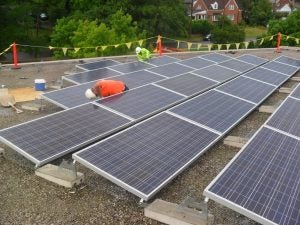Community solar program opens in Maryland
Maryland’s community solar pilot program officially opened for business on April 10. This comes almost two years after the legislation passed in Annapolis and after extended work by Public Service Commission (PSC) staff and other stakeholders, including MD SUN. While the program is technically open, many steps and several months of work lay ahead before offerings will become available to the general public. We expect energy subscriptions to start to be available for potential customers by late summer or early fall.
What happens next?
Now that the program is open, there are several steps project developers must go through to build shared arrays before they can offer energy subscriptions to potential customers. Out of fairness and due to high interest in the program, the PSC has arranged for the initial application process to be done in a batch and with specific timing for each stage.
Apply for a Subscriber ID – April 10 through May 5
The PSC will accept applications from organizations that want to participate in the program. These “Subscriber Organizations” may be for-profit developers, non-profits, municipalities, individuals, or groups of individuals. Each applicant will need to fill out a Subscriber Organization form and provide information about who they are and their plans. After the initial May 5 deadline for this first batch, new Subscriber Organizations can still apply to participate in the program. They will be accepted on a rolling basis throughout the year.
Receive a Subscriber ID – End of May
The PSC will issue subscriber IDs to applicants in the initial batch. The Subscriber Organization ID will be used by the applying Subscriber Organizations to identify themselves to the utility company and to keep their information up to date with the PSC.
Apply for Interconnection – Early June
Each participating utility (Pepco, Potomac Edison, BGE, Delmarva) will begin accepting Interconnection Applications for projects that Subscriber Organizations wish to connect to the utility grid as part of this program. Each Subscriber Organization will need to provide their previously issued Subscriber ID.
Each utility will then review these technical applications to determine if the requested solar facility can connect at the location requested and whether any additional costs are required to make the connection. The results of these applications will get returned to the Subscriber Organizations over a period of a few days to up to several months. Turnaround time will depend on a variety of factors including the size of the system and where it will be located on the electric grid. Larger sized projects will typically take longer to review.
Apply to join the program – Mid June
Once the Subscriber Organization has a “conditional approval” from the utility company that it’s allowed to build an array in the location requested, the Subscriber Organization can request space for that particular project in the program in one of three categories (“Open”, “Low-to-moderate-income”, or “Small & Special”). Each category is meant to encourage a variety of types of projects and has limited space allocated to it for each year of the program.
When they apply to the utility for space they must provide two other things: 1) proof they control the location where the array is going (example: a property lease) and 2) proof that they have applied for initial permits in the jurisdiction where the project is to be located (example: zoning permits).
Access to the program – Late June through December
Once the utility has received an application from a Subscriber Organization for a particular project to get space in the program they will review the application to make sure all the requirements described above are met. If space is available in the category requested the project will be permitted into the program.
When can I subscribe to community solar energy?
After projects are given space in the program the Subscriber Organizations will begin building (often with partner developers) the solar project and soliciting “Subscribers” (customers) to participate in the project. The remaining work, which includes construction, final interconnection to the grid, and commissioning, will typically take between 6 and 12 months but could be shorter for some projects depending on size, location, and other factors.
While the project is being built, Subscriber Organizations will be able to offer subscribers contracts to purchase energy (kilowatt-hours or kWh). Potential subscribers will be able to review the terms and conditions of a particular offer and decide whether they want to sign up or look for options from other Subscriber Organizations. Offer details like the cost per kilowatt-hour, the length of the contract, fees, cancellation options, etc. will vary by Subscriber Organization.
The rest of the pilot program
In years two and three of this pilot program more community solar will be built. The procedure for assigning access to the program will likely be similar to what we have described above but could be modified by the Public Service Commission based on the experiences of the first year.

